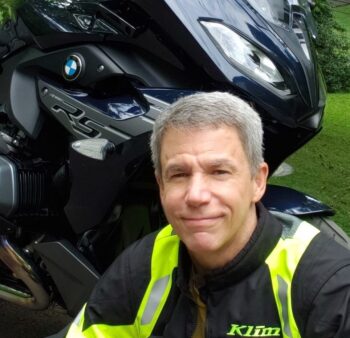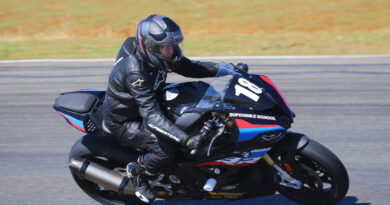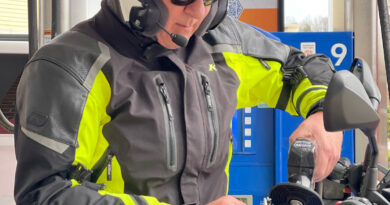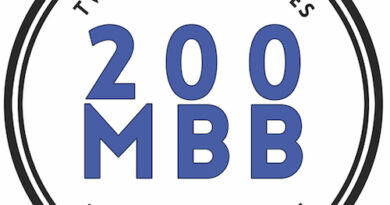Not what you think!
I just returned from a ride with an odd goal: find rain. I was trying to test the weatherproofing of Aerostich’s Transit 3 leather suit, which incorporates a unique combination of non-absorbent leather and a one-way water-permeable membrane to keep rain out while allowing water vapor to escape from inside. Although I could see multiple showers in the distance and on my Garmin Zumo XT’s handy live weather map, I was never able to catch up with one. Of course, had I been trying to avoid them, each one would have chased me down and taken its turn soaking me!
 Although my intended mission remained unaccomplished, I unexpectedly succeeded at another. I learned how the Transit 3 “worked” in the hottest, most humid weather encountered since I acquired it in early spring. Back when temps were cool and the air was dry, its comfort was impressive. This wasn’t surprising, given its high-quality materials, design and craftsmanship, but I’ve been wearing synthetic textile gear almost exclusively for many years, with all my old leather jackets and suits collecting dust—along with my memories of roasting inside them, soaked in sweat during summer rides, even when the leather was perforated. Once they became available, textile replacements with extensive venting or mesh panels were a most welcome relief, and I’ve rarely donned leather since making the switch. Despite Aerostich’s claims about the Transit 3 being an all-weather option and my longstanding regard for the company’s products, I was skeptical about using it through the worst of summer in the southeast, where temperatures and humidity typically hover together in the upper 90s. Things aren’t quite that bad here yet, so it remains to be seen how the Transit will feel in more extreme conditions, but my outing saw dash thermometer readings approaching 90 and, with all those pockets of rain around me, the atmosphere was dreadfully muggy.
Although my intended mission remained unaccomplished, I unexpectedly succeeded at another. I learned how the Transit 3 “worked” in the hottest, most humid weather encountered since I acquired it in early spring. Back when temps were cool and the air was dry, its comfort was impressive. This wasn’t surprising, given its high-quality materials, design and craftsmanship, but I’ve been wearing synthetic textile gear almost exclusively for many years, with all my old leather jackets and suits collecting dust—along with my memories of roasting inside them, soaked in sweat during summer rides, even when the leather was perforated. Once they became available, textile replacements with extensive venting or mesh panels were a most welcome relief, and I’ve rarely donned leather since making the switch. Despite Aerostich’s claims about the Transit 3 being an all-weather option and my longstanding regard for the company’s products, I was skeptical about using it through the worst of summer in the southeast, where temperatures and humidity typically hover together in the upper 90s. Things aren’t quite that bad here yet, so it remains to be seen how the Transit will feel in more extreme conditions, but my outing saw dash thermometer readings approaching 90 and, with all those pockets of rain around me, the atmosphere was dreadfully muggy.
Listen to this column as Episode 17 of The Ride Inside with Mark Barnes. Submit your questions to Mark for the podcast by emailing [email protected].
The Transit 3’s leather is perforated but allows no ingress of fresh air except through its relatively limited underarm and upper-back zippered vents. Those perforations only allow the waterproof and windproof membrane to pass moist vapor to the suit’s exterior. I would not have guessed this could produce much of an evaporative cooling effect and, indeed, it’s certainly not on par with a well-ventilated or mesh garment. However, I repeatedly noticed I wasn’t as sweaty and hot as I had expected. Aerostich also claims the special dyes used in this suit reflect more radiant heat than those used in conventional leather. I can’t vouch for this in any objectively measurable sense, but again, I noticed less impact than anticipated from the sun beating down on me between cloudy areas. I clearly recall similar conditions generating a lot of misery when wearing leather kit in years past, especially during the initial transition into hot weather when I hadn’t yet acclimated to the seasonal change (as is currently the case). It seems the Transit 3 actually does deliver significantly greater comfort than conventional leather as the mercury and humidity climb. I wouldn’t have believed this possible, and therefore I also wouldn’t have considered purchasing a Transit 3, regardless of the catalog’s description. My view changed only because Aerostich generously provided a sample for evaluation.

This column isn’t meant to be a review of the Transit 3. Rather, I’m trying to illustrate how things we think we know can prove quite inaccurate when tested. Only the most grandiose narcissist explicitly insists they’re never wrong about anything, but we all believe our own opinions and expectations as though we’re implicitly infallible; it’s just that some of us can occasionally take a more humble and accepting stance when evidence comes in to the contrary. It’s important to deliberately maintain a bit of doubt about our own perspectives, leaving room for new information to continually improve the accuracy and comprehensiveness of our views. For better or for worse, feelings are not facts, nor are ideas. Our thoughts and emotions almost always have some validity on the basis of our individual histories (they don’t just come out of nowhere), but they can become obsolete as our situations and selves change. Much damage and distress is a result of misapplying the past to the present. For example, the way I learned to relate to others in my family of origin may be way out of step with how I need to relate to (at least some of) the folks in my present circle of friends and coworkers. Whether we’re talking about leather riding suits or interpersonal dynamics, things can change a great deal over time and from one setting to another. We ignore the need for updating our understanding at our own peril; others we care about may suffer negative consequences from our rigidity, as well.
When I work with couples, one of the most common problems I encounter is a lack of curiosity. Each partner has become convinced they know all there is to know about the other one, and they work off the static models they’ve established in their minds as they interpret and react to each other. (This is also almost always the case between parents and their children.) The truth is no one is ever completely known by another person; we’re all way too complex and elaborate for this to ever be possible, and even if we were to be fully known one day, there would be new things to learn the next day about our experiences, thoughts and feelings since the previous assessment. I don’t mean partners are all wrong about each other, but those fixed models can contain plenty of inaccuracies, omissions, and outdated concepts that lead to seriously problematic misunderstandings. Much of couples therapy involves facilitating renewed exploration and discovery. Whereas this was what made the early stages of the relationship exciting, it eventually became intolerably stressful as one or both individuals reached a point where they didn’t really want to reveal any more about themselves or find out potentially disappointing or disturbing things about their partner. Curiosity got shut down to avoid anxiety, grief or the need to adjust, and as a result the relationship became stale and calcified. The partners no longer queried each other about how they saw or felt about things, and instead assumed and speculated on the basis of those old models—often in spite of new or different information their partner tried to present. This made their relational problems unsolvable.

Something similar happens in the garage. If I’m troubleshooting with a closed mind, thinking such-and-such must be what’s wrong or something else can’t possibly be the cause, I’m likely to miss clues that would lead me to a more accurate and useful appraisal. I’ve spent far too many hours tracking down gremlins that didn’t exist after overlooking extremely simple and obvious fixes (always check the kill switch first, no matter how certain you are you haven’t touched it since the last ride!). Even when I didn’t miss something basic, gaps in my knowledge have caused me to leave out certain paths of inquiry, eventually considered only after ruling out everything else or consulting someone with more sophisticated understanding. Had I realized the existence of such connections at the outset, I might have started with them and saved myself a tremendous amount of time, effort and consternation.

There’s a counterargument to be made here. We can’t go through every activity of every day without making any assumptions or we’d never get anything done. I’m not going to go through some systematic test of my office chair’s weight bearing capacity prior to each time I want to sit in it! The ability to assume is a big part of what makes memory an invaluable necessity in daily living and we’re right to take a multitude of things for granted. Our experiential histories allow us to make countless accurate predictions about what will likely happen in the future and judge which actions will yield the desired outcomes. The problem isn’t so much our tendency to assume, it’s how we often take our assumptions too seriously, foreclosing on the opportunity to learn when faced with a challenge. Assumptions must be made, but we ought to hold them loosely.
We need the flexibility to shift into scientist mode quickly when our assumptions don’t fit the emerging evidence. Forming new hypotheses and testing them in logical, methodical ways is the foundation of all scientific knowledge. Yet even the most rigorous and earnest scientist is vulnerable to a basic principle of human nature: instead of believing what we see (the scientific ideal), we tend to see what we already believe. We have to deliberately push against this tendency if we’re going to pry open space for new information at variance with our preconceived notions, and we need other people who can see things from different vantagepoints to help us notice our own blind spots (by definition, these cannot be discovered solo). This all takes real work and a great deal of humility.
On one hand, the human mind is unfathomably intricate and capable of astonishing feats – not just during moments of genius, but throughout mundane existence. It’s impossible to inventory all the stuff it manages, moment by moment, during a routine day. On the other hand, any particular mind’s processing can be profoundly constrained and distorted by its own idiosyncratic history of experience. Also, we can err in both directions: we might take our past experiences so seriously we’re unable to appreciate anything new, or we can not take our past experiences seriously enough and continue making the same mistakes going forward. There’s no way to “set it and forget it;” maintaining a reasonably successful life requires ongoing reevaluation of our own perspectives. To make this even more complicated, we can’t even be fully aware of ourselves, given the inevitable presence of blind spots and underlying layers of processing of which we may have little or no conscious awareness.
Learning never ends, or at least it shouldn’t. Thanks for the reminder, Aerostich!
Mark Barnes is a clinical psychologist and motojournalist. To read more of his writings, check out his book Why We Ride: A Psychologist Explains the Motorcyclist’s Mind and the Love Affair Between Rider, Bike and Road, currently available in paperback through Amazon and other retailers.



